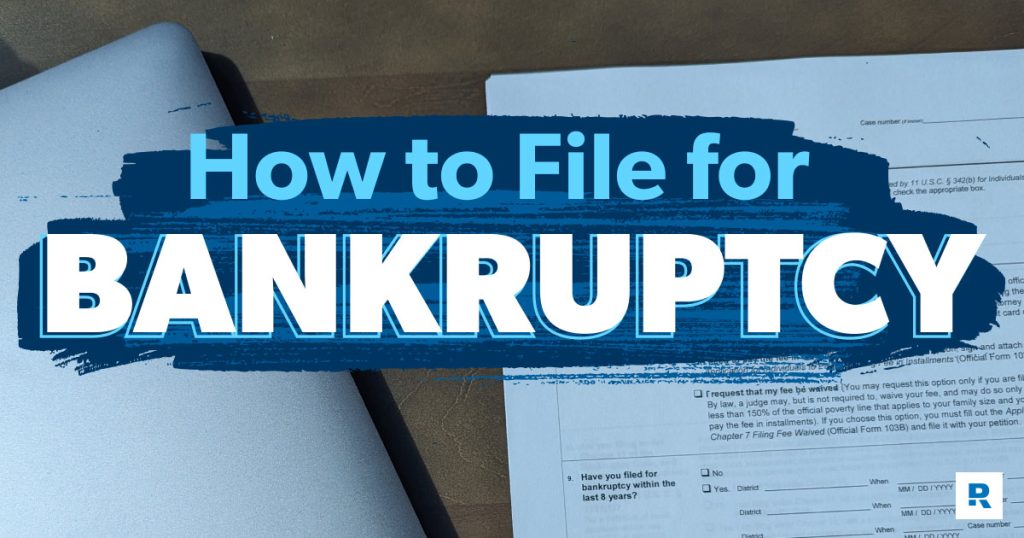If you feel backed into a corner by debt and you’re thinking about filing for bankruptcy, we see you. We know you’re scared. But you can get through this.
Let’s talk through what you need to know about filing for bankruptcy, so you can be as prepared as possible.
Should You File for Bankruptcy?
Bankruptcy is a long, gut-wrenching process. So, you need to be 100% sure it’s the right choice for your financial situation.
Many people panic and file as soon as the debt collectors start calling. But even if you’ve got a lot of debt, bankruptcy is rarely your only option. In fact, you should do everything in your power to avoid it.
And while bankruptcy can stop the repo man from taking your car, collectors from taking money out of your paycheck, and even the bank from foreclosing on your home, it doesn’t make all your problems go away.
For starters, bankruptcy doesn’t erase all debts, including:
Plus, a bankruptcy stays on your credit report for up to 10 years—which can keep you from getting a job, taking out a mortgage, or starting a business. So, even if it seems like bankruptcy will give you a fresh start, the cost might be more than you’re willing to pay.
Chapter 7 vs. Chapter 13
Chapter 7 and Chapter 13 are the most common types of bankruptcies for individuals. Which one you should file mostly depends on your income and what types of debt you have.
In a Chapter 7 bankruptcy, you’re forced to sell your stuff to pay back what you owe to creditors, and your unsecured debt (like medical bills and credit cards) is cleared. Most bankruptcy cases are Chapter 7.
Now, there are some exceptions to what you have to sell (aka exempt property). But the only way to guarantee that you get to keep your house, car or other assets is to reaffirm the debt—which means you agree to keep making payments on them. In order to qualify for Chapter 7 bankruptcy, the court has to decide if your income is too low to pay back your debt (this is called the means test).
With a Chapter 13 bankruptcy, you get to keep your stuff, but you also get put on a super tight budget and a court-approved plan to pay back some or all of your debt. To qualify for Chapter 13 bankruptcy, your total debt must be less than $2,750,000.1
How to File for Bankruptcy in 11 Steps
If bankruptcy really is your last resort, then it’s time to get prepared for the legal and emotional battle ahead. Let’s break down each step of the bankruptcy process, so you have an idea of what to expect.
Take a deep breath. You’re going to get through this.
Get help with your money questions. Talk to a Financial Coach today!
1. Consult a bankruptcy attorney.
2. Gather and organize the necessary documents.
3. Take the required credit counseling course.
4. Fill out the bankruptcy forms.
5. Print and double-check your bankruptcy forms.
6. Make sure you have your filing fee.
7. File your forms at your local bankruptcy court.
8. Mail documents to your bankruptcy trustee.
9. Go to the meeting of creditors (341 meeting).
10. Complete a debtor education course.
11. Wait for discharge and deal with any leftover debt.
1. Consult a bankruptcy attorney.
You could choose to file for bankruptcy without an attorney (it’s called filing pro se). But you’ll be a lot better off if you have a bankruptcy attorney in your corner.
So, just like you would hire someone to defend you in a trial, you want to hire a lawyer who’s handled their fair share of bankruptcies before. You need someone who can offer expert advice about what to do and help take some of the stress out of the process—especially when it’s time to fill out paperwork.
You can find a bankruptcy lawyer on the American Bar Association’s Legal Help website and through the Legal Services Corporation. Just a heads up, though—bankruptcy lawyer fees aren’t cheap. But if you can’t afford an attorney, you may be able to get free legal help.
2. Gather and organize the necessary documents.
The first thing you need to do is figure out where you stand with your finances. Your money situation is going to be center stage throughout the whole bankruptcy process, so if there was ever a time to be organized, it’s now.
Documents You Need to File for Bankruptcy
List of Your Debts
- Your credit report (Get a copy of your free yearly credit report from each of the major credit bureaus—Experian, TransUnion and Equifax—or on annualcreditreport.com.)
- Medical bills
- Credit card statements
- Records of any personal loans, car loans or tax debts
- Any proof that you owe anyone money
List of Your Income
- Tax returns for the past two years
- Pay stubs for the past six months or longer
- Current investment and retirement account statements
- Bank account statements for the past six months or longer
- Proof that anyone owes you money
List of Your Assets
- Real estate documents and mortgage statements
- Vehicle registration and information
- Value of property (List out how much your stuff is worth, especially your car and any real estate you own. You can group other items into categories—such as clothes, electronics, etc.)
- Property tax exemptions
- Receipts or invoices for any major purchases you made in the last year (appliances, cars, jewelry, etc.)
Other Documents
- Personal identification (like your driver’s license and Social Security card)
- Any documented communication you’ve had with your creditors
- Insurance policies
- Any previous lawsuits you were involved in
- A detailed list of your monthly living expenses (food, utilities, shelter, transportation, etc.)
A bankruptcy lawyer will be able to tell you more about the exact documents you’ll need for your specific situation. But if it’s got to do with your debts, income or assets, you’ll probably need it.
And once you’ve gathered your records and made copies, put them in a specific bankruptcy file so you can get to them easily.
3. Take the required credit counseling course.
Everyone who files for bankruptcy has to take a credit counseling course that’s approved by the Department of Justice. In this course, you and someone from a credit counseling agency will talk about your finances to decide if bankruptcy is really the right choice.
The credit counseling course:
- Must be completed within 180 days before you file for bankruptcy
- Usually takes about an hour to complete
- Can be taken in person, online or by phone
- Costs around $10–50, depending on where you take it (but if you don’t make enough money to pay for the course, you can have the fee lowered or waived entirely)
Once you finish the course, make sure you keep your certificate of completion—you’ll need it when you file!
4. Fill out the bankruptcy forms.
Okay, you made it this far. Now it’s time for the paperwork. This is the most mind-numbing step in the process, but it’s important to get everything as exact as possible if you want your case to be approved.
Go ahead and get comfortable, because you’ll have to fill out a bunch of forms (they’re all free to download here). You’ll also need additional forms based on the state you live in and your specific case. These 70-plus pages ask you about your income, how much you spend, what you owe, what you own and more. (This is where all those documents you gathered in Step 1 come in handy.)
Now, we’re going to be real with you—there are a lot of details and plenty of math involved in this step. This is when you basically have to prove to a judge that you can’t make ends meet because of your debt.
This part will be a lot easier if you have an attorney helping you. But if you’re not able to hire a lawyer, try using a bankruptcy software that will help you figure out what forms you need. Some even let you file electronically.
5. Print and double-check your bankruptcy forms.
When you print out your bankruptcy forms, keep in mind that the court is pickier than a college English professor. Here’s an important rule: Your forms need to be single-sided or the court won’t accept them (and that would mean more work for you and a lot of wasted paper).
Most courts only need one copy of the petition (that’s the section of the bankruptcy paperwork that proves you aren’t able to pay back your debts). But some courts want as many as four copies. So, you’ll need to double-check with your local bankruptcy court to nail down the exact number to print out. And of course, you’ll want to save a copy for yourself.
After your forms are printed, go ahead and sign them so you’re ready for the next step.
6. Make sure you have your filing fee.
Bankruptcy isn’t cheap. On top of attorney fees, you also have to pay a fee just to file for bankruptcy. The total filing fee for a Chapter 7 bankruptcy is $335, and for a Chapter 13 bankruptcy it’s $310.2,3 You’ll have to pay this amount in exact change to the court in person.
If you don’t have the money to cover the filing fee, you can ask for a payment plan to space out your fee (up to four payments over 120 days). Or if money is really tight, you can submit a form asking for the fee to be waived.
7. File your forms at your local bankruptcy court.
Now it’s time to head to your local courthouse and turn in your bankruptcy forms. Not every experience is the same, but here’s a general play-by-play of what you can expect when you go to file for bankruptcy in person:
After you go through security, head to the clerk’s office (this is the person responsible for handling court records). The only thing you need to tell the clerk is “I’m here to file for bankruptcy.” This is also when you give them your bankruptcy forms (don’t forget your credit counseling course certificate) and the filing fee in exact change (or the forms for a payment plan or fee waiver, if that’s you).
Then you’ll take a seat while the clerk processes your case. It usually only takes about 15 minutes or so for them to scan and upload your forms into the court’s system. Then the clerk will give you some important info that you need to hang on to:
- Your bankruptcy case number
- The name of your bankruptcy trustee
- The date, time and location of your meeting with your trustee (aka the meeting of creditors)
At this point, your bankruptcy case is officially filed.
From now until the end of your case, debt collectors are legally not allowed to contact you to get money because of what’s called an automatic stay. Also, creditors can’t take money directly out of your paycheck, and any foreclosures or car repossessions are put on pause.
But filing your bankruptcy forms doesn’t mean you’re in the clear yet. There are some other key steps you have to take before your debts are gone.
8. Mail documents to your bankruptcy trustee.
Once you’ve filed, you should be given the name of your bankruptcy trustee. A bankruptcy trustee is someone appointed by the court to handle your case. Sometimes they’re lawyers, but not always.
Your trustee will ask you to send them certain documents like tax returns, pay stubs and bank statements. So, pay close attention to your mail and make sure you do everything the trustee says if you want your debts erased.
9. Go to the meeting of creditors (341 meeting).
About 20–40 days after you file, you’ll have the meeting of creditors (also known as the 341 meeting because it refers to Section 341 of the Bankruptcy Code). This is when you sit down with your bankruptcy trustee to make sure you didn’t leave out any important info in your paperwork—like forgotten debts or assets.
Unfortunately, like the name suggests, your creditors (aka the people you owe money to) are also on the invite list. But they don’t always show up. If they do, it’s usually to find out if you’re giving up an asset (like a car or boat) or if you’re reaffirming the debt in order to keep it (which means you’re also keeping the payments).
This is the time to ask any questions you have about your case. It’s also your chance to file an objection (or a formal complaint) if you feel a creditor has claimed a debt that’s not true. So, come prepared and don’t be afraid to speak up!
And even though this meeting doesn’t take place in a courtroom, you’re still under oath. So be honest and let the trustee know if there are any changes you need to make to your bankruptcy file. The last thing you want to do is seem like you’re hiding something.
10. Complete a debtor education course.
While you wait for your case to be processed, you’ll also need to complete a second financial management course—specifically, a debtor education course.
Bankruptcy isn’t something you want to go through once, let alone multiple times. The goal of the debtor education course is to teach you how to make smarter money choices moving forward.
The debtor education course:
- Needs to be completed within 60 days of your first meeting of creditors
- Usually takes at least two hours
- Costs between $10–50 (unless you’re eligible for a waiver)
Remember, you must complete this course if you want your debts cleared.
11. Wait for discharge and deal with any leftover debt.
You’re almost done! But there are still a couple of things that need to happen before your bankruptcy case comes to a close, depending on which type of bankruptcy you filed.
If you filed Chapter 7, your debts will be cleared as soon as your trustee sells your nonexempt assets and pays off your creditors. Chapter 7 usually takes a couple of months from start to finish.
If you filed Chapter 13, you’ve got to complete the payment plan and make sure all your creditors get their money before your debts can be erased. The whole process takes about three to five years, so don’t count on your debts being erased right away. And if you fall behind on payments or don’t stick to the plan, your case could be dismissed, putting you back at square one.
When your bankruptcy case is closed, you should get a letter in the mail telling you your debts have been cleared. Otherwise, you can always contact the clerk’s office or check your case online, if your trustee gave you that option.
As soon as your debts are discharged, you’re no longer legally required to pay back those debts. So hold onto that bankruptcy discharge letter as proof!
But remember, if you’ve got any secured debt that you reaffirmed (usually a car loan) or any debt that wasn’t bankruptable (like those student loans), you still need to take care of that ASAP.
Before You File for Bankruptcy
As you can see, bankruptcy isn’t a quick or painless process. And it could take months or years before you feel any relief. You may even go through the whole filing process only to not qualify for bankruptcy.
We know it may feel impossible right now, but there are ways you can knock out your debt without filing for bankruptcy: selling your stuff, increasing your income, negotiating with your creditors—and most importantly, getting on a budget. These things can help you get back on your feet.
Trust us, paying off your debt on your own terms is a whole lot better than being forced to do it on the bankruptcy court’s terms. But if bankruptcy is the path you decide to take, you can get through it. There is life after bankruptcy.
Read the full article here












